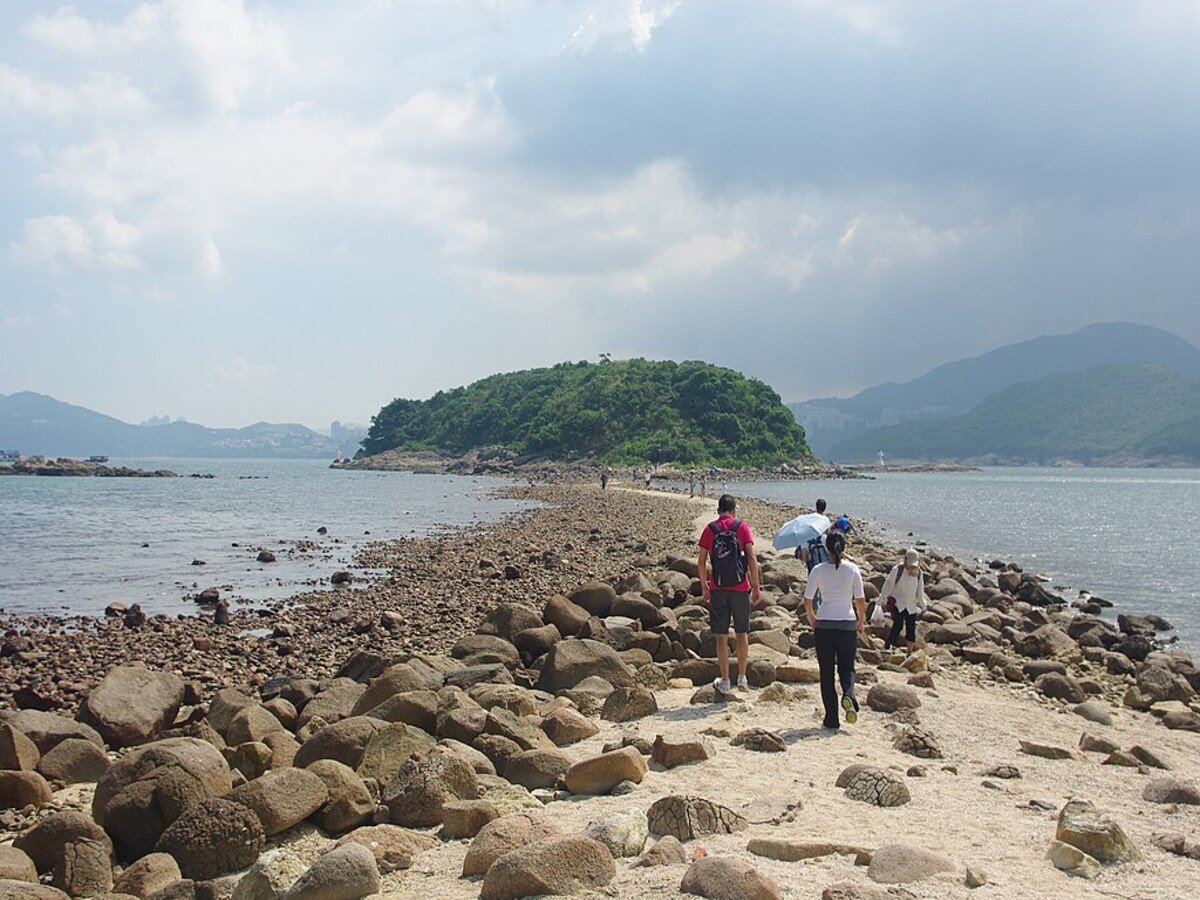Bookmark These Pretty Islands For Your Next Trip to Hong Kong
The sugar soft beaches, colourful fishing villages and wild geoparks of Hong Kong’s islands are an easy boat trip from Central.
Hong Kong’s true charm lies in its ability to hold the non-stop buzz of a metropolis while hiding more than 260 beautiful islands - each unique and just a short hop from Kowloon or Hong Kong Island. If you’re in Hong Kong for longer than a brief layover, or if it’s not your first rodeo and something a little different, take to the water and disembark on one of these tropical hideaways, which feel a world away from the city streets. Here’s our gudie to the best islands in Hong Kong…
Cheung Chau
If you’re not sure where to start when exploring Hong Kong’s islands, peaceful and laid-back Cheung Chau is the ideal starting point. Its waterfront is home to dozens of colourful boats vying for space, but the island itself is far less chaotic. You’ll find seafood restaurants lining the waterfront, soft crescents of golden sand and gentle paths that wind through its landscapes. Stepping off the pier into Tung Wan, take time to stroll among the little boutiques, souvenir shops and cafes. Cheung Chau’s snacks are ever-popular, and not only its famous buns*, but stalls selling classics like fish balls, grilled squid, mango mochi and more.
For a little dose of history, Pak Tai Temple is one of the island’s main draws, which is ornately decorated and one of the oldest Taoist temples in Hong Kong. To feel the sand underfoot, Tung Wan’s beach and Kwun Yam Beach are the closest but a little further, Pak Tso Wan Beach offers more seclusion on busy days. Stretch your legs on a walk along the island’s ‘Mini Great Wall’ which is a short, stretch of oceanfront path that runs along the Cheung Chau Family Trail or visit the North Lookout Pavilion for impressive views over the island.
The Cheung Chau annual bun festival coincides with the Buddha’s birthday, and draws thousands of visitors to Cheung Chau each year. During the seven day event, there are colourful parades, lion dances and celebrations, culminating in a nail-biting ‘bun snatching’ competition in which competitors scale huge structures, with the aim to collect as many bao buns as possible. Plan your visit in advance as ferries fill up quickly during the festivities.
Getting there: Take a ferry from Central Pier No.5 to Cheung Chau, a service which runs daily and with increased frequency during the bun festival. The fast ferry takes less than 40 minutes.
Tai O
Lantau Island is one of Hong Kong’s biggest, so if you’re searching for a place you can squeeze into half a day, make time to visit Tai O. This charming fishing village is on the western coast of the island and its bright houses on stilts and scenic surroundings are a welcome change from the city.
And views come in spades on nearby trails such as the short climb up to Tiger Mountain (Fu Shan) or the longer, four-hour Tung O Ancient Trail. Although the fishing industry has somewhat dried up in Tai O, its roots still shine through in the delicious seafood to be found here. Fresh oysters, fish and prawns are just a few options on the menus at restaurants, and to pair it with a view, we suggest Tai O Lookout at the historic Tai O Heritage Hotel for lunch. Tai O has another surprise in store - hop on a guided sampan boat tour to admire the houses and you might be lucky enough to spot a pink dolphin.
Each year, usually in May or June, Tai O hosts its incredible Dragon Boat Water Parade, where sacred statues of deities are sailed along the aters on colourful sampans - it’s an event not to miss if you’re in Hong Kong for the Dragon Boat Festival.
Getting there: Tai O is reachable via a combination of MTR, bus and ferry. Jump on the MTR to Tung Chung Station, before catching the 11 bus, which takes around 45 minutes to reach Tai O. Alternatively, consider getting the ferry from Central Pier No. 6 to Mui Wo, from where bus 1 also takes roughly 45 minutes. If you’re combining a visit to Tai O with other sights on Lantau Island, a more time-efficient but pricier route is to take the MTR to Tung Chung Station, hop on the cable car to Ngong Ping Village to explore the sights, and then board bus 21 (20 minutes) to Tai O.
Lamma Island
Lamma Island is slowly filling up with quirky locals and expats, but there’s still so much to discover here, even if you've been before. It’s the perfect blend of Hong Kong’s thrumming culture and slow-paced island life. The two main villages on Lamma Island are Yung Shue Wan and Sok Kwu Wan, linked by a beautiful walking trail and both featuring a diverse range of cafes, food spots and unencumbered views. Before settling into one of these popular spots, take advantage of Lamma’s scenic hikes. The Lamma Island Family Trail between the two villages passes white sand beaches, temples and emerald forest, and if those beaches appear too crowded, there’s plenty more on the island.
Outside of June - October, Sham Wam Beach is the only green turtle nesting site in the South China Sea; meanwhile, Lo So Shing is the spot for total seclusion and on Hung Shing Ye Beach, barbecues and the chatter of locals are just the vibe for watching a sunset. You can’t visit Lamma Island without sampling its impressive array of cafes and restaurants, either: our top picks are Dale Candela, for fresh Spanish plates; Banyan Bay Cafe for the best all-day breakfast on the island and Corner84, where you can pick up freshly baked pastries for your hike.
Getting there: Lamma Island is easily reached in 30-40 minutes from either Central or Aberdeen, heading to Yung Shue Wan and Sok Kwu Wan
Sharp Island
This UNESCO Geopark is simply the most accessible in Hong Kong, whether you’re keen to get active by scaling its rocky outcrops, tackle a hike or are searching for epic views. Kiu Tsui Pier Beach is the first of two beach options where sparkling waters promise excellent swimming and kayaking. For a quick leg-stretch, the Sharp Island Geo Trail is just 500m long, but leads to sweeping vistas over Clearwater Bay. This trail includes, at low tide, the famous stoney tombolo which connects Kiu Tsui Beach to the small islet of Kiu Tau.
Sharp Island’s geopark accreditation comes from its ancient volcanic history - rocks from the Cretaceous Period can still be seen everywhere on the island, including the weathered pineapple bun rocks which resemble Hong Kong’s most loved snack. But most people make the journey here for the Sharp Island Hiking Trail - only 1.6km but providing panoramic views over the bright blue waters of Hap Mun Bay (Half Moon Bay), which happens to be the best place on the island to feel soft sand underfoot and go snorkelling in the surrounding waters.
Getting there: To reach Sharp Island, either hop on the MTR to Choi Hung Station (Exit C2) followed by minibus 1 or 1A to Sai Kung Pier, or take the MTR to Diamond Hill followed by bus 92. Then, you’ll need to board a sampan which depart regularly for Sharp Island. We recommend stocking up on snacks and drinks at the pier, as there are limited options once you arrive.
Tung Ping Chau
It’s an easy day-trip from Hong Kong and one to add to your list if you love nature, hiking and beaches. This may sound exactly like every other Hong Kong island we’ve mentioned, so let us explain its allure. Tung Ping Chau is another one of Hong Kong’s Global geoparks, and more than 50 million years of history can be seen in the rock formations across the island, such as the unique geometric stones jutting out at Lung Lok Shui, and the dramatic layered formations at Kang Lau Shek.
You can take in a swathe of these while walking the Ping Chau Country Trail which follows the coast and takes around 2 hours. If geology doesn’t float your boat, check out the quiet Tai Tong Wan Beach or Cheung Sha Wan for snorkelling in bright, aquamarine waters teeming with tropical fish - Tung Ping Chau Marine Park houses dozens of marine species and brightly coloured coral within a 270 hectare area. Note that as one of Hong Kong’s most remote islands, food choices can be thin on the ground. You can find the best options around Tai Tong Wan, otherwise ensure you arrive well prepared.
Getting there: Take the MTR to University Station, hop on bus 272K to Ma Liu Shui Public Pier and then board the ferry to Tung Ping Chau. Note that ferries only run on Saturdays (9AM, 3:30PM), Sundays (9AM only) and public holidays, and take around 1.5 hours. There is only one return ferry departing at 5:15PM - make sure not to miss it.
Tap Mun (Grass Island)
It’s small but it packs a punch - Tap Mun is all rippling green grass, windswept trails and quiet waterfront. The main buzz is around Hoi Pong Street, where stalls sell local delicacies and handicrafts, there are a couple of standout seafood restaurants and nearby, the historic 400-year-old Tin Hau Temple. Further along down an alleyway, to the left of King Lam School, the hiking begins on a trail that takes visitors around the southern coast of Tap Mun, taking in stellar views from Hilltop Pavilion and Long King Pavilion, both of which have seating to rest weary legs. Keep an eye out for directions to another island attraction, Balanced Rock; two large boulders perched precariously on top of each other.
The relatively easy trail finally winds through the island’s colourful fishing villages of yore, Tap Mun New Fishermen's Village and Yung Shu Village, where the trade is all but gone, and back to Tap Mun Pier. You’re likely to enjoy the charm of Tap Mun without any disturbance, so take a picnic or sample the fresh seafood on this under-the-radar Hong Kong island.
Getting there: Take the MTR to University Station (Exit B), and head to Ma Liu Shui Ferry Pier by taxi to catch a kaito to Tap Mun, taking around 1.5hrs .Alternatively, from Sai Kung take bus 94 to Wong Shek Pier, where a kaito takes around 35 mins.










